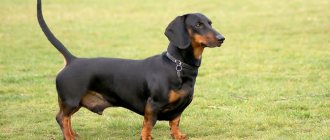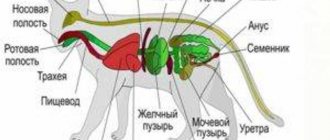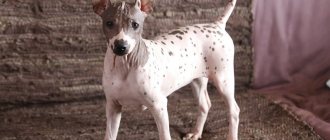Excursion into history
Among naturalists of the 19th and 9th centuries, there was an opinion that various breeds of domestic dogs originated from wild ancestors that had the same basic characteristics as the modern breed.
In other words, it was believed that each group of breeds had its own wild ancestor, for example, mastiffs descended from a wild dog, which had all the characteristics of mastiffs, shepherd dogs and huskies - from a wolf, decorative breeds - from various combinations of canids: a jackal, a fox, a raccoon and some small wild dogs. This is understandable; the variety of breeds of domestic dogs, their external differences, naturally suggest that these animals have completely different roots. And the geographical discoveries of that time gave reason to think so. Wild dogs were discovered in the jungles of India, wild dogs were found in Africa, and even in Australia, a continent so remote and cut off from the rest of the world by the expanses of the ocean, there were also wild dogs. Scientists of that time were confident that in ancient times the earth was inhabited by a large number of wild dogs with different appearances and qualities, and a person could only choose those that best met his requirements, catch the puppies and tame them. Subsequently, almost all dogs were tamed, and only a small part continued to exist in the wild. It was believed that the domestication of dogs began in the Bronze Age, with the advent of primitive forms of cattle breeding, and this happened about 4 - 5 thousand years ago, although the fact was not denied that some breeds of hunting dogs could have been domesticated much earlier.
But the development of zoology forced scientists to change their view of the origin of the domestic dog. It was established that the dog became a dog precisely as a result of domestication, and before that it was a completely different animal, perhaps a wolf, jackal or coyote.
The history of the origin of dogs on the planet
To date, archaeologists have not agreed on a single version about the origin of dogs on Earth.
Most scientists believe that the domestic dog appeared about 33-35 thousand years ago in Southeast Asia. This conclusion was made thanks to a detailed analysis of the genetic diversity of pets.
About 15,000 years ago, the ancestors of our favorites began their movement from the southern borders of China to the Middle East and towards African countries. Some 5,000 years later the migration reached Europe.
Another team of archaeologists believes that the first domesticated breeds arose in Europe approximately 10-14 thousand years ago. However, DNA studies show that the first pets could equally have appeared on the African continent and in Asian countries.
British scientists are confident that the places of origin of the first species coincide with the geography of the gray wolf, the main population of which was based in Eurasia.
The domestication process could have occurred in several regions at once, rather than in one place.
The same trend is characteristic of the domestication of other animals, such as cows and pigs. Therefore, English scientists say that the search for a single birthplace of domestic animals is a dead-end branch of research.
Domestic dogs live on every continent, and the diversity of their breeds is amazing.
Fossil dogs
In 1862, the remains of an ancient dog were discovered in Switzerland. The scientist Gütimeyer, who examined this artifact, named it the turf dog (Canis familiaris palustris Rutimeyer). Its skull is small (size 140 mm) with a short, narrow and thin facial part, clearly separated from the skull. The occipital protuberance is poorly expressed.
It was a medium-sized Spitz-like dog that had all the signs of domestication; many modern breeds of Spitz, schnauzer, pinschers, and terriers trace their ancestry from it. And also German Huskies, Doberman Pinscher, Doberman Pinscher, Airedale Terrier and Giant Schnauzer. The remains of a peat or swamp dog have been repeatedly found in Europe in layers dating back to the 2-3 millennium BC.
Another fossil dog breed, the Inostrantsev dog (Canis & Inostranzewi), was discovered by Russian geologist A.A. Foreigners. In 1882 on the shore of Lake Ladoga. Its skull is 177 mm with a flatter forehead and a less pronounced transition to the muzzle, well-developed zygomatic arches and occipital protuberance. The muzzle is short, wide with strongly developed jaws and large teeth, approaching those of a wolf.
Professor D.N. also found fossil remains of a similar dog. Anuchin in excavations near Lake Ladoga. Judging by the skeleton, it was a large and strong individual, bearing a certain resemblance to the Northern European wolf . Probably, northern huskies and some breeds of shepherd dogs (herding dogs) originated from similar dogs.
Dogs of the Stone Age include Putyatin's dog , the skull of which was found, in a single copy, on the territory of the former Novgorod province near the city of Bologoye. It is very close to the Inostrantseva dog , but the skull is shorter (167mm) and narrow in the cranial part, with a longer muzzle (virtually indistinguishable from the skull of modern dingoes), it is possible that the descendants of this dog are some breeds of Laika.
In 1872, the skull of a dog called the “ Bronze Dog ” (1200 - 1000 BC) was found. The era to which the find dates is characterized by the rapid development of crafts, the spread of cattle breeding and settled agriculture. Skulls of “bronze dogs” were repeatedly found on the territory of Bronze Age settlements, both in Europe and in the burials of the Andronovo and Karasuk cultures in Siberia and Central Asia. Almost all shepherd dogs trace their ancestry from these dogs. The bronze dog's skull is characterized by a flat forehead with a slight transition to a long and narrow muzzle. When viewed from above, the skull has the appearance of a narrow wedge, the occipital protuberance is well defined. It is larger than the skull of Inostrantsev’s dog and Putyatin’s dog, its size is 165 – 190 mm.
Another type of Bronze Age dog is the so-called “ ash ” or “ ash ” dog. Skulls were found in the ash remains of sacrificial hearths. It is obvious that the ashen dog was a hunting dog, and dogs that died during the hunt were subjected to ceremonial burning or, perhaps, sacrificed as a sacrifice, as the most expensive value owned by the primitive hunter. Skulls that are similar in structure to ash dogs were described by Professor D. A. Brauner during excavations on the Amur River. He also described the skulls of ashen dogs found during excavations of a Sarmatian settlement in the North Caucasus in the vicinity of the village of Elizavetinskaya , near the city of Krasnodar . Various skulls of ashen dogs were found in the ash pits of the Scythian Velsk settlement. The skull of ash dogs is quite wide in the brain part, with a flat forehead, with a well-defined transition to a relatively blunt and short muzzle. The length of the skull ranges from 174-184 mm. According to scientists, all hunting dogs - hounds, pointers, spaniels and dachshunds - can be considered descendants of ash dogs.
Back to the beginning of the article
Population composition
Data based on DNA studies demonstrate significant genetic differences between dogs from two different geographic regions. It also indicates a dramatic change in the composition of the population on the European continent. As a result, the earlier dog population was simply displaced.
Apparently, this was directly related to the massive influx of dogs from other regions, such as East Asia. According to research results, the ancestors of modern dogs arose in Eastern and Western Europe about 12 thousand years ago, but they appeared in the regions of Central Asia only about eight thousand years ago.
With a high degree of probability, it can be argued that the original population of ancient wolves was divided into western and eastern Eurasian wolves. They were domesticated independently of each other, but the wild species itself eventually became extinct for an unknown reason.
At some point after this domestication, probably around 6,400 years ago, dogs from the east traveled with their owners towards Europe. It was some kind of massive and important resettlement. There they already mixed with ancient European dogs, even partially supplanting them.
Modern hypotheses
Research by scientists at the beginning of the 20th century pushed back the date of the start of dog domestication by another ten thousand years.
Today, the question: “Where did the domestic dog come from?” - there is no definite answer. One group of scientists defends the theory of the origin of the dog from the wolf, another - from the wolf and jackal, the third - from an extinct ancestor - the wild dog. Most modern scientists consider the ancestor of the dog to be the wolf. Even according to scientific classification, the domestic dog is classified as a subspecies of the wolf.
Scientific classification: Domain:
Eukaryotes
Kingdom:
Animalia
Phylum:
Chordata
Class:
Mammals
Subclass:
Animals
Order:
Carnivores
Suborder:
Canidae
Family: Canidae Genus: Wolves Species:
Wolf
Subspecies
:
Dog International scientific name : Canis lupus familiaris Linnaeus, 1758
Biologist J.P. Scott from the University of Ohio, in his research, found that the domestic dog has 90 characteristic behavioral traits, for example, raising its paw when urinating, circling before lying down, etc. Of these, 71 signs are characteristic of the wolf. It should be noted that the missing features are the least noticeable, and in addition, it is possible that they simply were not noticed when observing wolves in the wild (the technical complexity of such observations should be taken into account here). Some traits associated with hunting behavior are also missing. At the same time, the behavior of the jackal and coyote has much less common features with the dog, but in terms of blood composition the dog is closest to the jackal.
The variety of dog breeds and the great difference in physiological characteristics indicate that the process of domestication of dogs was quite diverse. And perhaps different breeds of dogs were obtained from different combinations of ancestors, these could be wolves, and jackals or coyotes, and wild dogs, yes, and other representatives of the canine family. It should be noted that previously it was considered impossible to obtain viable offspring from a jackal and a wolf, or from a jackal and a domestic dog, due to their chromosomal differences, but, according to the latest data, almost any combination of representatives of the Canis family produces completely viable offspring.
According to science, the conscious domestication of dogs began approximately 14 thousand years ago. A number of scientists consider the long-extinct species of wild dog to be the ancestor of the dog. In archaeological excavations, skeletons and skulls of dogs that have not yet been domesticated are found. These wild dogs lived 10 - 15 thousand years ago and gave rise to the domestic dog, possibly from one or more, probably from seven, extinct species according to the number of main groups of domestic dogs (greyhounds, Spitz-type dogs, etc.). Or from a special species of extinct small wolf Canis volgensis. It is this wolf-like dog, according to N.K. Vereshchagina was probably the common ancestor of primitive breeds of domestic dogs. The later hybridization of domesticated Volga wolves with the gray wolf was quite probable already in the early stages, i.e. in the Neolithic and Bronze Ages. Nowak (1979) considers the extinct species of wolf, C. etruscus, to be the probable ancestor of the domestic dog and the modern wolf.
Finally, some authors believe that one of the dog's ancestors could have been an extinct species similar to the coyote. Such species were widespread throughout Eurasia, and one of the oldest domestic dogs, the peat dog, descended from coyote-like ancestors. Inostrantsev’s dog is a product of crossing primitive Spitz dogs with wolves.
Back to the beginning of the article
Where did dogs come from?
There are still two theories about the origin of these animals. According to the first monophyletic, these animals have only one ancestor in their genus. For a long time it was believed that the ancestor of the modern dog was the gray wolf, because it is not without reason that many breeds of domestic animals are similar in appearance to this predator.
The wolf is a relative of modern dogs
However, over the past few years this theory has been successfully refuted. The central arguments are:
- molecular DNA analysis of the remains of ancient dogs and wolves indicates a great disunity in genetics between these animals;
- the skulls of these animals found during excavations are not similar to each other;
- All experiments carried out on crossing these two animals did not give the required result. The hatched specimens continued to be aggressive;
- experiments to domesticate the wolf have so far ended unsuccessfully. It turned out to be impossible to overcome the natural caution of the predator;
- The physiological characteristics of a wolf are superior to those of a dog.
For your information! Most scientists are of the opinion that the dog comes from jackals. It is they, and not wolves, who can approach villages where people live, and in difficult times they can feed on waste, unlike gray predators who, out of hunger, are ready to attack prey rather than pick up food.
According to the second polyphyletic theory, the origin of dogs goes back not to just one historical root, but to several. The following arguments are given to prove this:
- in different areas of the earth, fragments of skeletons of prehistoric dogs from the same period of existence, but different in body structure, size and other physiological characteristics, are found;
- Scientists have repeatedly experimented with crossing dogs of different breeds, but as a result they received specimens that were similar to each other. The conclusion suggests itself that if there had been a single ancestor, modern dogs would not differ much from each other;
- The outstanding Austrian zoologist and zoopsychologist K. Laurens developed his theory of the origin of dogs. According to her, these domestic animals have jackal-wolf heredity, but in different proportions. The temperament of the beast depends on the predominance of one blood or another.
Taming (domestication) of a dog
True domestication began when people began to select the offspring of dogs that had the most attractive characteristics for humans, to tame and cultivate certain qualities that were useful in this or that matter.
This was the beginning of breeding. This happened approximately ten thousand years ago, when human society reached a level of development in which new activities such as cattle breeding and agriculture appeared. Different types of behavior were also required from dogs used in various areas of human activity. So the psychotype and physiology of a hunting dog had to be different from a shepherd dog, and even more so from a fighting dog. Through selective selection, man has learned to consolidate the useful and suppress unnecessary or harmful qualities of a dog. This gave rise to the development of various breeds of domestic dogs. A little later, an exterior direction in dog breeding emerged. Decorative breeds appeared that were simply human companions and delighted the eye with their bright and unusual appearance. This direction received its greatest development in ancient China.
With the development of cattle breeding, the dog became an indispensable assistant for primitive cattle breeders. Not only did the shepherds graze their cattle on foot, but the animals themselves were not yet obedient enough. The herds were often attacked by predators. And the main task of herding dogs was to protect livestock from wild predatory animals. This also determined the type of dogs - they had to be strong, vicious, hardy, capable of resisting a predator in single combat. This is how the first mastiffs appeared. Subsequently, such dogs began to be used during military operations. For this purpose, the most aggressive animals that had no fear of humans were selected. They gave rise to breeds of fighting dogs, which were very successfully used by nomadic tribes for warfare. This tactic was borrowed and developed by the Romans during their wars to expand the borders of the empire. It should be noted that the most numerous group of domestic dog breeds are shepherd dogs, or herding dogs. Subsequently, breeds of service, guard and rescue dogs were developed from representatives of this group.
Back to the beginning of the article
Dog phenotype and dog breeding
As we have already found out, the history of the origin of dogs has not been fully studied. It is difficult to say with absolute certainty who they came from. But even greater interest lies in artificial selection and selection. There are about four hundred different dog breeds. They differ in height, weight, color, shape of ears and tail, and many other markers of domestication.
The type of activity whose main goal is to breed and improve dog breeds is called dog breeding. Selective selection is primarily based on the purpose of breeding a particular breed of dog. There are three directions: decorative, hunting and service. For each there are certain requirements: weight, height, head, muzzle, nose, etc.
Pedigree mysteries: where did dogs come from?
Author Oleg Artyukov
30.12.2005 15:23
Unknown » Past
I am holding in my hands the skull of a dog that lived 15 thousand years ago. It is well preserved, the fangs of the ancient dog look impressive. The skull was found in one of the Siberian caves and is the oldest among those so far discovered by archaeologists. Were the first dogs domesticated in Siberia?
Genealogy mysteries
When and where did domestic dogs first appear? It would seem that dog breeders should have a clear and unambiguous answer to this question, but the opposite is true. Books by cynologists say little about the origin of man's four-legged friends, and there are more than enough ambiguities and uncertainties. Let's try to clear up the confusion.
The dog is the oldest domestic animal; the first dogs lived next to our ancestors back in the ancient Stone Age. Therefore, we can agree with modern researchers who say that it is difficult to establish the truth - everything happened too long ago. But difficult does not mean impossible, and then it is not clear why science has not yet made its verdict?
The point is probably that not only archaeological, but also commercial and even political interests are associated with the question of the origin of dogs. Now there are more than 400 breeds in the world, many of them are bred for sale, and every breeder wants to somehow distinguish their product from others. From ancient times, they shift the public's attention either to the fighting mastiffs of Babylon and Rome, who in armor entered the battlefield or the arena of the Colosseum, or to the Pekingese, which amused Confucius and Qingshihuang, or even to the naked decorative dogs, which the ancient Aztecs used for ritual purposes . The most unceremonious dog breeders even started talking about the fact that the ancestors of their purebred product are dogs from Atlantis.
But why not trace the family tree back to the Stone Age? There is also this - the arguments are the remains of the so-called “peat dog”, discovered back in 1862 in Switzerland and dating back to the 10th millennium BC. Well-preserved skulls and bones are found in peat deposits along with logs from pile villages of the Middle Stone Age of the Mesolithic, which is why such dogs are sometimes called “pile dogs,” and based on external features, this small dog is well suited to the role of the ancestor of modern Spitz, pinschers, terriers, etc.
It is this similarity, as well as its “European origin,” that has led to the fact that the turf dog is most often called the first domestic dog. There is no doubt that for the ancient people who lived in huts under the protection of lake and river waters, a guard dog was extremely important, which barked to greet strangers and guarded the house on stilts at night from uninvited guests. It is clear that she did not need a large size either - the “security alarm biosensor” needed little and was cheap. But it is just as obvious that long before the appearance of pile villages, people had other dogs. They were strong and resilient, helping them in hunting fast deer and powerful mammoths, and it was also important to smell a saber-toothed tiger hiding in the grass. Here, of course, it is not a Spitz that is needed, but someone else. Such a dog was the Siberian Laika - an amazing breed that has survived to this day.
It is not only the lobby of commercial dog breeders that prevents the canine community from recognizing this fact, but also typical European snobbery - because then it turns out that in Siberia the achievements of the Paleolithic stone civilization were more significant than in Europe or the Middle East.
Indisputable facts
In Krasnoyarsk, in the laboratory of archeology and paleogeography of Central Siberia, which is headed by historian and archaeologist Professor Nikolai Ivanovich Drozdov, special attention is paid to the mysterious history of ancient dogs. After all, it was in Krasnoyarsk near the Yenisei River, during excavations of Paleolithic sites on Afontovaya Mountain in the 80s of the 19th century, that archaeologist I.T. Savenkov found one of the first dog skulls of the Stone Age. Scientists already knew about European peat dogs by that time, but the discovered I.T. Savenkov and determined by biologist I.D. Chersky's Siberian dog was clearly older - based on the nature of the Paleolithic site, it could be attributed to the era of 20 thousand years ago. Here were also the bones of a mammoth, a cave lion, a giant deer - those animals that the first dogs helped people hunt.
Unfortunately, they later tried to forget the sensational fact. The bones, transferred for research to St. Petersburg, are still stored somewhere in the storerooms, and not on the front display case of the museum. Western archaeozoologists, for obvious reasons, preferred to pass over the Siberian finds in silence (although in 1931, in publications in French, the Soviet researcher of Scythian-Hunnic dogs M.V. Pavlova recalled this). And the Russian authorities on archaeozoology had their own favorite finds: the so-called dog A.A. Inostrantseva found on Ladoga, and the dog P.A. Putyatin from the White Sea - remains no older than 10 thousand years. By the way, the last of those named is known in the form of only one skull. As for the large wolf-like dog Inostrantsev, described by Professor D.P. Anuchin, this interesting species gained fame in the West and finally eclipsed the glory of the ancient Siberian huskies.
If you read publications about the origin of dogs, you will be surprised to discover that Afontovo’s oldest dogs, in terms of species, manage to be identified simultaneously with both Inostrantsev’s dog and the turf dog. The confusion shows that in fact no one here is interested in searching for the truth, and the very principle of identifying ancient remains is not clear: comparison of single bones does not allow one to make sufficiently well-founded generalizations. In fact, these are not scientific conclusions, but guesswork and a statement of prestige. Fortunately, even modest Siberians have awakened to ambition.
In 1998, candidate of biological sciences Nikolai Dmitrievich Ovodov published abstracts in the materials of the international congress in Canada - this remarkable forum of archaeozoologists was dedicated to ancient dogs, and the Siberian’s message aroused interest. At least there were questions via email. Nikolai Ovodov’s message not only talked about Savenkov’s findings, but also cited a new sensational result: in Altai, in the Razboinicheya Cave, employees of the Krasnoyarsk Laboratory of Archeology and Paleogeography excavated the skull of a dog in a layer dated by radiocarbon at 14,850 + - 700 years. Today, these are without a doubt the oldest remains of a domestic dog from the Stone Age.
People and animals
We got a little carried away with questions of priority, but the reader would probably like to know - who did pets come from, and how did it all happen? There were many speculative hypotheses on this score - mainly they paid attention to external similarities: if the dogs are large - from a wolf, small - from a jackal, a fluffy tail - a fox or arctic fox was noted. But you can endlessly compose folk tales, but a rigorous genetic analysis recently carried out by scientists from the Royal Swedish Institute of Technology clearly established: it was the wolf and only the wolf that was the ancestor of domestic dogs. In Latin, their classification names are consonant with Canis lupus - wolf and Canis familiaris - domestic dog. Genetic analysis yielded another unexpected result: samples taken from dogs from different regions were compared molecularly, and East Asia was named as the most likely area of origin for domestic dogs. Here again is a paradox: Western European researchers by East Asia do not mean Siberia and our Far East, but China and Japan. But the migration of dogs along with humans from Asia to America in the Stone Age is a long-established fact (the Bering Strait did not exist then). So wouldn’t it be more correct to conclude that Paleolithic people with their dogs settled in America, Japan, and the territory of present-day China from one center - from Central Siberia?
The remains of a wolf and a dog differ sharply - and not only in size (dogs are always smaller), but also in the structure of the skull and teeth. Nikolai Ovodov shows their jaw bones for comparison: the dog’s teeth are closed, while the wolf’s have gaps. How did an evil predator turn into a devoted friend? There are two versions. One of them is exotic, they say, a pack of wolves got used to living next to a tribe of people, eating up the remains of prey that ancient hunters threw away, and also participating in the hunt as self-proclaimed beaters + The story is interesting - you could write a whole novel, but there is too much far-fetched here - in the spirit of tolerance and friendship of everyone and everything that is now fashionable. And most importantly, the symbiosis cannot be traced from archaeological finds: man and wolf have always remained enemies and competitors.
A much more likely story is that little wolf cubs ended up in the tribe after people destroyed the nest and killed their fanged parents. Just like this happens now, when hunters take in wolf cubs or bear cubs - for fun and out of practical interest. It is known that month-old wolf cubs recognize their owners as their real parents, and in the same way the tribe became their own pack. If the abundance of game allowed, domesticated wolves could live among people from generation to generation - and sooner or later a sharp change occurred, when a new species of animals with sharply different characteristics arose.
By the way, there is a theory that for humans, symbiosis with dogs became an evolutionary impetus - the senses and brain got rid of the purely animal functions of sniffing and listening, which made it possible to use mental resources more wisely. And vice versa, the dog’s brain acquired the basic skills of intelligent behavioral programs, which enriched the animal’s psyche and was reflected at the genetic level. Subsequently, cooperation grew into real friendship - on the territory of Siberia in the Irkutsk region, in Transbaikalia and Kamchatka, ritual burials of dogs of the late Stone Age are known: a four-legged friend wears a necklace around his neck with the fangs of animals, which were celebrated as prize medals for their victories in a joint hunt . And in the south of our region, on the territory of the Minusinsk Basin, in Bronze Age burials they no longer find hunting dogs, but the first shepherd dogs - the ancestors of modern shepherd dogs. Archaeozoologists note the chronologically simultaneous appearance of a new species of domestic sheep - so here, too, the role of the helper dog can hardly be overestimated.
Monument to the first dog
So, a clear chain, based on facts, is being built: the first dogs on Mount Afontova and the dogs from the Altai cave are the beginning, 15 thousand years into the past. Such similar finds are evidence of species stability and the large distribution area of the already established domestic dog. Then - several thousand years later - hunting dogs in Neolithic ritual burials in Siberia and the Far East. These are all large animals, the ancestors of Siberian huskies, which scientists therefore call laikoids. Lycoids are universal dogs that can drive a deer, follow the trail of a wounded mammoth, struck by spears and arrows. They successfully distract a bear or a cave lion, allowing people to defeat the terrible beast. And in subsequent eras, the shepherd dogs of the steppe states of the Bronze Age (the so-called “bronze dog”) appeared from these same laikoids.
At the same time, huskies continued to exist, and in not so distant times they also became sled dogs. It should be noted that since wolves are a very old species (its age is more than 800 thousand years), its contact with humans also lasted a very long time and, perhaps, domestic dogs appeared in different places and then mixed. So, for example, the bronze dog has a certain similarity with the Indian wolf. But, one way or another, according to modern data, the first domestic dogs were born in Central Siberia - the species was stable and successfully spread throughout North-East Asia, moving to America.
And the fact that it was these peace-loving and brave, strong and hardy dogs that were the ancestors of today’s Siberian Laikas is obvious. And it is no coincidence that it was Laika who became the first living creature to rise beyond the boundaries of planet Earth into space! This feat of our four-legged friend was marked with memorial signs, but it would be correct to erect in Siberia on the slope of the Krasnoyarsk Afontovaya Mountain - above the blue expanse of the Yenisei - a special beautiful monument to the first dog, which became a faithful friend for the ancient hunter. This initiative was put forward by scientists from the research center - let's hope that dog lovers from all over the world will support this initiative of the Siberians.
Pavel Poluyan, Krasnoyarsk
Topics housing dogs Irkutsk White Sea archeology arguments and facts
European and Asian dogs
Most dogs today are a cross between Eastern and Western dogs, which is why scientists have had such a hard time figuring out the DNA of modern dogs. Researchers say that some of the oldest breeds, such as the Siberian husky and the Greenland sled dog, have genes that are characteristic of both the Western Eurasian and East Asian branches.
The new study has answered many questions, but there is still a lot of work ahead. For example, with regard to the Eurasian dogs that then came to Europe, the theory of a single common origin does not seem plausible. The problem is that archaeological evidence is not yet sufficient to confirm or refute this conclusion.
In the future, researchers hope to combine ancient and modern genetic data, conduct archaeological research and their detailed analysis, so that the history of dog domestication does not have any “blank spots.” To do this, it is necessary to create, bit by bit, a refined chronology of events and fully explore the geography of the origin of man's best friend.
Scientists also intend to compare the DNA of ancient dogs and the Australian dingo, which most likely descended from East Asian dogs. If no traces of European DNA are found in dingoes, this will provide further evidence in favor of the new theory of double domestication of dogs by humans.











